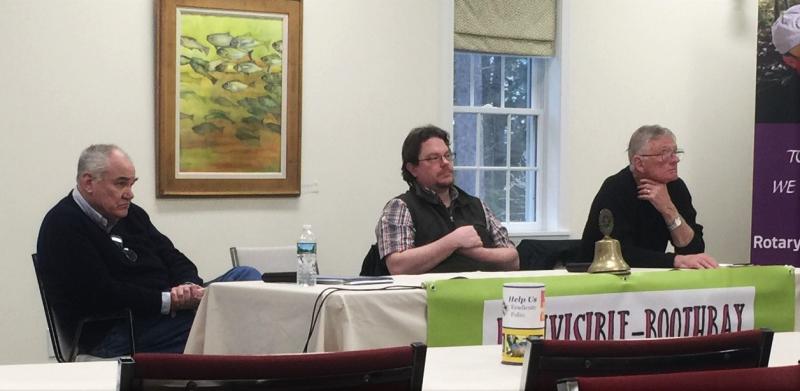Indivisible-Boothbay holds panel on freedom of the press
About two dozen people piled into the Rotary Club of Boothbay Harbor for a panel discussion on freedom of the press April 23. Indivisible-Boothbay organized and hosted the event, with member Nat Wing serving as moderator.
Joe Gelarden, Boothbay Register columnist and Indianapolis Star veteran reporter, and John Swinconeck, executive editor of the Times Record in Brunswick were the guest speakers leading the discussion. Two of the four scheduled panelists – Cliff Schechtman, executive editor of the Portland Press Herald, and Laura Seay of the Washington Post blog “Monkey Cage” and assistant professor at Colby College – were unable to attend.
Gelarden kicked off the discussion by bringing up fake news.
“While the current occupant of the White House has spent much of his time criticizing fake news and calling the press ‘the enemy of the people,’ he's not the first leader to pick a fight with the Fourth Estate,” said Gelarden, launching into the story of John Peter Zenger.
In 1733, the journalist and publisher ran a series of stories in the New-York Weekly Journal in critique of Royal Governor William Cosby and his use of power to replace members of New York's supreme court over a pay raise. A libel charge put Zenger in prison for eight months before he was acquitted by a jury of his peers, said Gelarden. He said historians say Zenger's trial was the first documented case in America of a journalist criticizing government.
Gelarden followed with other stories from the 19th century such as Elijah Parish Lovejoy, a Maine native murdered for his vocal opposition to slavery, and Alexander Manly, owner of African American newspaper the Daily Record in Wilmington, North Carolina. Manly was run out of town, and his press and building were destroyed. Black neighborhoods were attacked with 30-100 people killed, said Gelarden.
Arizona Republic reporter Don Bolles, who covered the Chicago mafia, was killed in 1976 from a bomb planted in his car. In 2018, five newspeople were killed at the Capital Gazette in Annapolis, Maryland – Rob Hiaasen, Gerald Fischman, John McNamara, Rebecca Smith and Wendi Winters.
History has shown journalists have time and again put their livelihoods, reputations and lives on the line in putting information before the public, said Gelarden; however, while this history and current events may be troubling, Gelarden believes they are not the greatest threat to press freedom.
“When you read your news feed, do you pay for that information? … Do you read the Register? Do you get the Daily Catch? How many of you subscribe to the Register," Gelarden asked.
Aggregates like Huffington Post, The Daily Beast, RedState and Breitbart News often run stories from papers like the New York Times and Chicago Tribune, he continued.
“Do you know how much they make on those stories? Nothing. Zero.”
Bringing the concept closer to home, Gelarden said if something of national or global interest were to happen at Bath Iron Works, for example, the Times Record would likely be the first paper on the scene. The story to come from that, from a beat reporter working under the direction of Swinconeck, would almost certainly be picked up from these massive aggregates with little to no attribution and no compensation.
“I'm convinced that the greatest threat to (freedom of the press) is the failure of our business model that has sustained over the last century,” said Gelarden. “… As ads for news fell, newspapers cut back on news stories and many cut back on their coverage of the state house, the courts and the local city hall – business, sports, culture, entertainment and regional news … It's not only small papers like this, the big boys are in trouble, too.”
The San Diego Tribune has been bought and sold three times over six years, noted Gelarden, and his longtime employer, The Indianapolis Star, along with its parent company Central Newspapers Inc., was sold in 2000 to Gannett Company for $2.6 billion. Gannett, owner of about 100 papers across the country and several radio and television assets, is now worth about half the cost of that acquisition.
Gelarden contrasted this with Amazon.com president and CEO Jeff Bezos' purchase of the Washington Post for $250 million as well as the New York Times 1993 purchase of Affiliated Publications (Boston Globe) for $1.1 billion and subsequent sale 20 years later for $70 million to Red Sox and Liverpool Football Club owner John Henry.
“Those are firesale prices, ladies and gentlemen, firesale prices,” said Gelarden. “… The press needs to continue to hold government accountable. We all agree about that and I assure you we will. But we also need to figure out how to convince the public, the advertisers and others to pick up the tab. We have to find a way to pay the bills and in my mind that is absolutely the greatest threat to freedom of the press.”
Swinconeck took a more global approach as he mentioned a couple more cases from abroad which highlight the occupational hazards of journalism: Reuters journalists Wa Lone and Kyaw Soe Oo recently lost their appeals of seven-year sentences for reporting the killings of 10 Rohingya in Myanmar. On April 18, Lyra McKee, a journalist from Derry, Northern Ireland, was shot and killed by a member of the New IRA, minutes after a conditional agreement designed to begin bringing down the wall between Ireland and Northern Ireland.
“The New IRA has since apologized ... but there we go – one more journalist in the grave,” said Swinconeck before bringing the discussion full circle back to the Capital Gazette slayings. “… Being on American soil doesn't consign a journalist to safety. We're branded as an enemy of the people at home and abroad. We're told that we're ‘fake news’ – whatever that means …”
Freedom of the press is an ideal “woven into the fabric of democracy,” said Swinconeck. A pillar of the first amendment, journalists, editors and all news media continue to endure attacks from government officials. So with all the trouble surrounding the profession, Swinconeck said the real question is why journalists continue to do what they do.
“The hours are horrible, the pay is crap, and every time we report on ourselves, it's to note that the industry is in really rough shape. So why do we do it? I suspect the same reasons why many other people are called to public service whether that's a nonprofit, or government, or a church. I strongly feel that journalists have a desire for a better society. It's my belief that we only grow through empathy and through knowledge and you can get both of those … by reading your local newspaper.”
It’s also the difference in occupational culture, Swinconeck said. “One of the things that separates legitimate news services and businesses and organizations is our willingness to take ownership of our mistakes … You'll see corrections probably more so than I would like, but we'll always own up to (it).”
Swinconeck said part of the larger problem, especially in broadcast journalism, is instant gratification, instant analysis to developing issues – commonly known as the CNN Effect to j-schoolers.
“There's no time for digestion or, god forbid, fact-checking what just happened … If we want to look at keeping a viable free press, I think what we need to do is, number one, raise our standards and, number two, have some realistic expectations. It's like fast food: You can get it right away and it'll be hot, but it may not be that good for you.”
Only one thing is certain about the future of news, said Gelarden: Someone still has to go out and get it no matter how it ends up reaching society.
“As for the rest of it, where's it going to go? Nobody knows,” said Gelarden. “The brightest people, the academics, people at the Poynter Institute and Nieman (Foundation) and other people – nobody knows.”
Said Swinconeck, “I've been hearing for 20 years … that print is dead, print is dying and the internet is taking over … I'm just waiting for it to actually happen. So, if it's going to happen – happen. But so far there seems to be a viable print industry. It's not as robust as it once was, it's had to change with the times, but 20 years later it's still here.”
Event Date
Address
United States
























